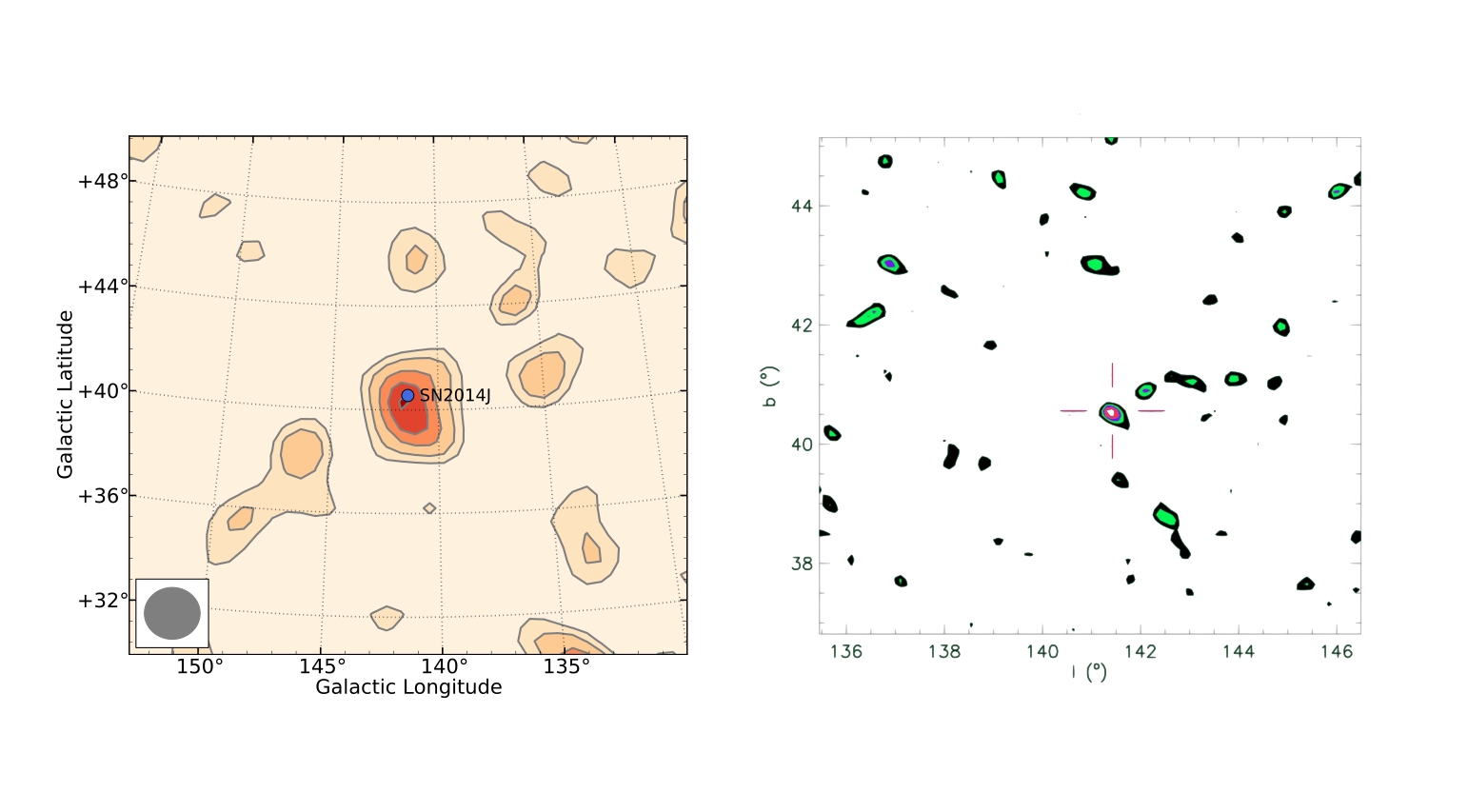ESA’s Integral Picture of May, the detection of the first thermonuclear supernova with gamma rays [NOT TRANSLATED]

The INTEGRAL space mission has detected for the first time a thermonuclear supernova with gamma rays. This is the SN2014J, a Type Ia supernova that exploded on Jan. 21, 2014 in M82, the Cigar Galaxy. The results of the study had been published in the journal Astronomy & Astrophysics and are the INTEGRAL picture of May on the ESA website.
Type Ia supernovae
Type Ia supernovae are the outcome of the thermonuclear explosion of a carbon/oxygen white dwarf in a stellar binary system. During this explosion significant amounts of radioactive isotopes are synthesized, the most abundant being 56Ni which decays to 56Co and further to 56Fe. The decay of these radioactive isotopes produces gamma-rays that thermalize and are responsible of the luminosity of the supernova. As the expansion of the debris proceeds, matter becomes more and more transparent and an increasing number of gamma rays avoid thermalization and escape. These escaping gamma rays can be used as a diagnostic tool for studying the structure of the exploding star and the characteristics of the explosion.
Unexpected results
Jordi Isern, researcher at the Institute of Space Sciences (IEEC-CISC) and responsible for the international team that conducted the study explains that “the results discussed in this article do not correspond with any model of type Ia supernova explosion known as suggests the presence of the radioactive isotope 56Ni in external layers and moving at high speeds. If confirmed, this completely unexpected result would force to rethink current ideas about the spread of the explosion and the distribution of ashes in the outer layers of the type Ia supernovas”.
“In this sense.” concludes Isern “the detection and analysis of gamma ray emission in other supernova explosions are of the utmost importance to determine the origin and development of these events.” we must remember that these explosions are responsible for the existence of almost all the iron in the galaxy and, thanks to its brightness, it was discovered that the Univers expands rapidly due to the existence of dark energy.
2016-05 (1)
The figure on the left displays the count rate contours obtained by SPI during the period 16—35 days after the explosion in the energy band,145—165 keV, which contains the most prominent line of 56Ni: the 158 keV line. As it can be seen, the maximum of the emission coincides with the position of the supernova and it is clearly isolated from the neighboring sources. The excess in the position of the supernova is 5 sigma.In the low energy region, the analysis of the SPI data has shown the presence of a completely unexpected broad, redshifted feature related to the 158 keV 56Ni line. The redshift, ~3.2 keV, indicates that the radioactive material is receding from the observer at a velocity ~6,000 km/s, while the width of the line, ~4.9 keV, suggests a dispersion velocity of ~10,000 km/s. The figure on the right displays the gamma-ray signature of SN2014J in the IBIS/ISGRI data. The plot represents the signal-to-noise contour map in the 67.5—189 keV band obtained during the same period as SPI. As before, the supernova is clearly isolated from the neighboring sources and the average excess in the supernova position is 5.4 sigma.
Article reference
J. Isern, P. Jean, E. Bravo, J. Knödlseder, F. Lebrun, E. Churazov, R. Sunyaev, A. Domingo, C. Badenes, DH Hartmann, P. Hoeflich, M. Renaud, S. Soldi N. Elias – Rosa, M. Hernanz, E. Domínguez, D. García-Senz, GG Licht, G. Vedrenne, P. Von Ballmoos. Gamma-Ray emisión from SN2014J near maximum optical light. Astronomy & Astrophysics. 588, A67 (2016). [NOT TRANSLATED]
